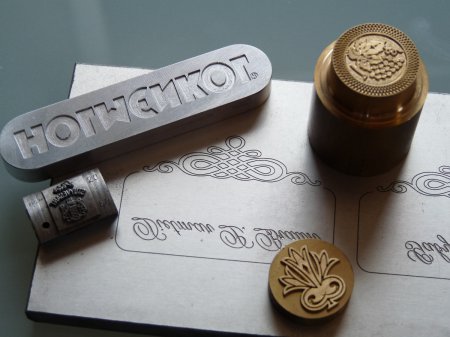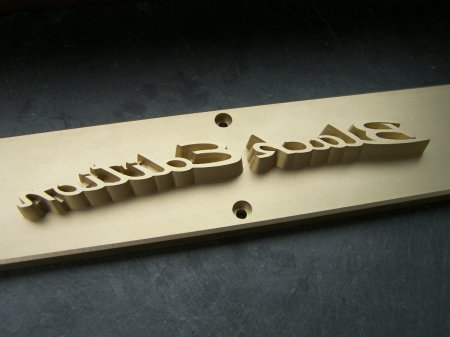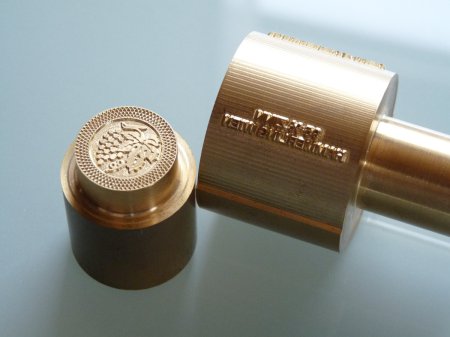Stamps and embossing tools
The specialist for embossing tools and stamps
 During embossing, lettering, logos, or specific motifs are engraved into a workpiece in a recessed manner. This can be done by different embossing tools and methods, which is why the right embossing tool is the basis for proper embossing. To ensure a good embossing result, the embossing dies are engraved by our modern multi-axis CNC machines.
During embossing, lettering, logos, or specific motifs are engraved into a workpiece in a recessed manner. This can be done by different embossing tools and methods, which is why the right embossing tool is the basis for proper embossing. To ensure a good embossing result, the embossing dies are engraved by our modern multi-axis CNC machines.
The use of CNC machines in the production of embossing tools has several advantages. The work with these machines is characterized by their high precision, so that the embossing tools are created from real precision tools. The tools are easily reproducible as often as required, and just as precisely, so that even larger series can be made quickly. This can save time and costs, especially for larger and extensive productions.
LES GRAVEURS offers many different variations of tooling designs to transform your individual design ideas into unique and distinctive embossing.
Various embossing die variants
- Hot stamping
Hot stamping dies are used in particular in the packaging industry and are usually made of brass. In the hot stamping process, hot stamping foils and structural foils are applied from the carrier foil to the object to be stamped by means of pressing force and heat. The embossing foil type, heat and duration are matched to the material and object selected in each case with this method. The marking is either colorless blind embossed or colored with matching foils. The advantage of hot stamping using foils is that they are very durable and allow comprehensive marking. In addition, the drying times for many products are very short, enabling faster further processing. - Branding irons
Branding irons are stamp models that can engrave different materials, such as wood, by heating. Branding irons are equipped with a brass plate in which the corresponding motif is engraved. Not only a single motif can be used, but also different ones, as the stamp has an interchangeable plate system. Branding irons can be heated in different ways. The most commonly used branding irons are electrically operated. Electricity is used to bring the stamp to the correct temperature, which remains constant, allowing for consistent work. An alternative is the gas-heated branding iron, which is powered by a gas cartridge that can be replaced. - Hand stamps
Hand stamps are the oldest form of embossing stamps and are mainly used for individual embossing of e.g. company logos. In this process, the stamp is placed on the selected workpiece at the desired location by hand and struck with a hammer on the rear end. In this process, the embossing depends on the embossing person, as skill, experience and strength significantly influence it. - Machine stamps
Unlike hand embossing stamps, machine stamps are used in particular for larger series production. This requires a stamping press or a striking mechanism integrated into the production process. The stamp, which is usually made of steel, is pressed into the machine and fixed in place. Due to the fact that a technically generated, uniform pressure is created and with an exactly adjusted embossing angle, the machine stamp can also contain large-area inscriptions without jamming. This form of construction and an extensive range of embossing punches allow for very many, different areas of application, whereby the adjustable impact performance can be achieved with little effort. - Embossing types and type holders
Embossing types and type holders enable variable embossing of workpieces. They are used for individual character combination of letters, numbers and logos and are made of brass or steel. For marking, these embossing types can be fixed in a type holder. In this way, a marking image can be embossed entirely according to your ideas, whereby the use of a press is advantageous for larger fonts. In addition, single types or type blocks for already existing type holders or embossing machines can be manufactured and supplied. - Leather embossing stamps
Various processes and tools are used for leather embossing. Which leather embossing stamp is suitable also depends here on the desired embossing and on the selected leather.
Embossing and marking rollers
- Embossing rollers
Embossing rollers represent a simple, precise and cost-effective variant for marking turned parts during the production process in automatic lathes or machining centers on the circumference or on the face of a workpiece. The embossing roller can be integrated directly into the tool magazine of the production line when using a suitable roller holder. - Signing rollers
Signing rollers are characterized by the fact that they have a circumferential engraving that is used to emboss. This form of embossing tool is particularly suitable for continuous marking. In continuous marking, a material is marked lengthwise with a repeating text, which is relevant for bars, for example. This allows the embossing to be carried out seamlessly and more quickly.
FAQ – Stamps and Embossing Tools
Contact Us




